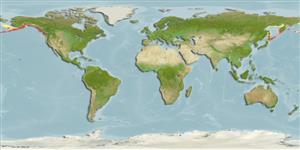Teleostei (teleosts) >
Perciformes/Cottoidei (Sculpins) >
Agonidae (Poachers) > Anoplagoninae
Etymology: Anoplagonus: Greek, ana = up + Greek, oplon = shield + Greek, gone = birth, generation (Ref. 45335).
More on author: Günther.
Environment: milieu / climate zone / depth range / distribution range
Ecology
Marine; demersal; depth range 8 - 102 m (Ref. 2850). Temperate; - 39°N
North Pacific: Bering Sea to Point Arena, northern California, USA. Korean records may be based on a different species (Ref. 27436).
Size / Weight / Age
Maturity: Lm ? range ? - ? cm
Max length : 15.0 cm TL male/unsexed; (Ref. 2850)
Short description
Identification keys | Morphology | Morphometrics
Dorsal spines (total): 0; Dorsal soft rays (total): 5 - 6; Anal spines: 0; Anal soft rays: 4 - 5. Dorsal fin small; caudal well rounded; anal small, under dorsal; pectorals with fleshy rays, the last 3 with ends free from membrane (Ref. 6885). Brown dorsally, brownish gray below; darker band from snout to base of pectoral; vertical dark bars on pectoral and oblique bars on dorsal fin formed by mottling, minute spots on anal, faint dark bars across body; caudal fin dark with light patches dorsal and ventral (Ref. 6885).
Often found among rocks (Ref. 2850). Usually caught by shrimp trawlers (Ref. 4925).
Life cycle and mating behavior
Maturity | Reproduction | Spawning | Eggs | Fecundity | Larvae
Eschmeyer, W.N., E.S. Herald and H. Hammann, 1983. A field guide to Pacific coast fishes of North America. Boston (MA, USA): Houghton Mifflin Company. xii+336 p. (Ref. 2850)
IUCN Red List Status (Ref. 130435: Version 2024-2)
Threat to humans
Harmless
Human uses
Fisheries: bycatch
Tools
Special reports
Download XML
Internet sources
Estimates based on models
Preferred temperature (Ref.
123201): 3.4 - 10.1, mean 6.7 °C (based on 240 cells).
Phylogenetic diversity index (Ref.
82804): PD
50 = 0.7500 [Uniqueness, from 0.5 = low to 2.0 = high].
Bayesian length-weight: a=0.00355 (0.00134 - 0.00941), b=3.13 (2.90 - 3.36), in cm total length, based on LWR estimates for this (Sub)family-body shape (Ref.
93245).
Trophic level (Ref.
69278): 3.3 ±0.1 se; based on size and trophs of closest relatives
Resilience (Ref.
120179): High, minimum population doubling time less than 15 months (Preliminary K or Fecundity.).
Fishing Vulnerability (Ref.
59153): Low vulnerability (10 of 100).
